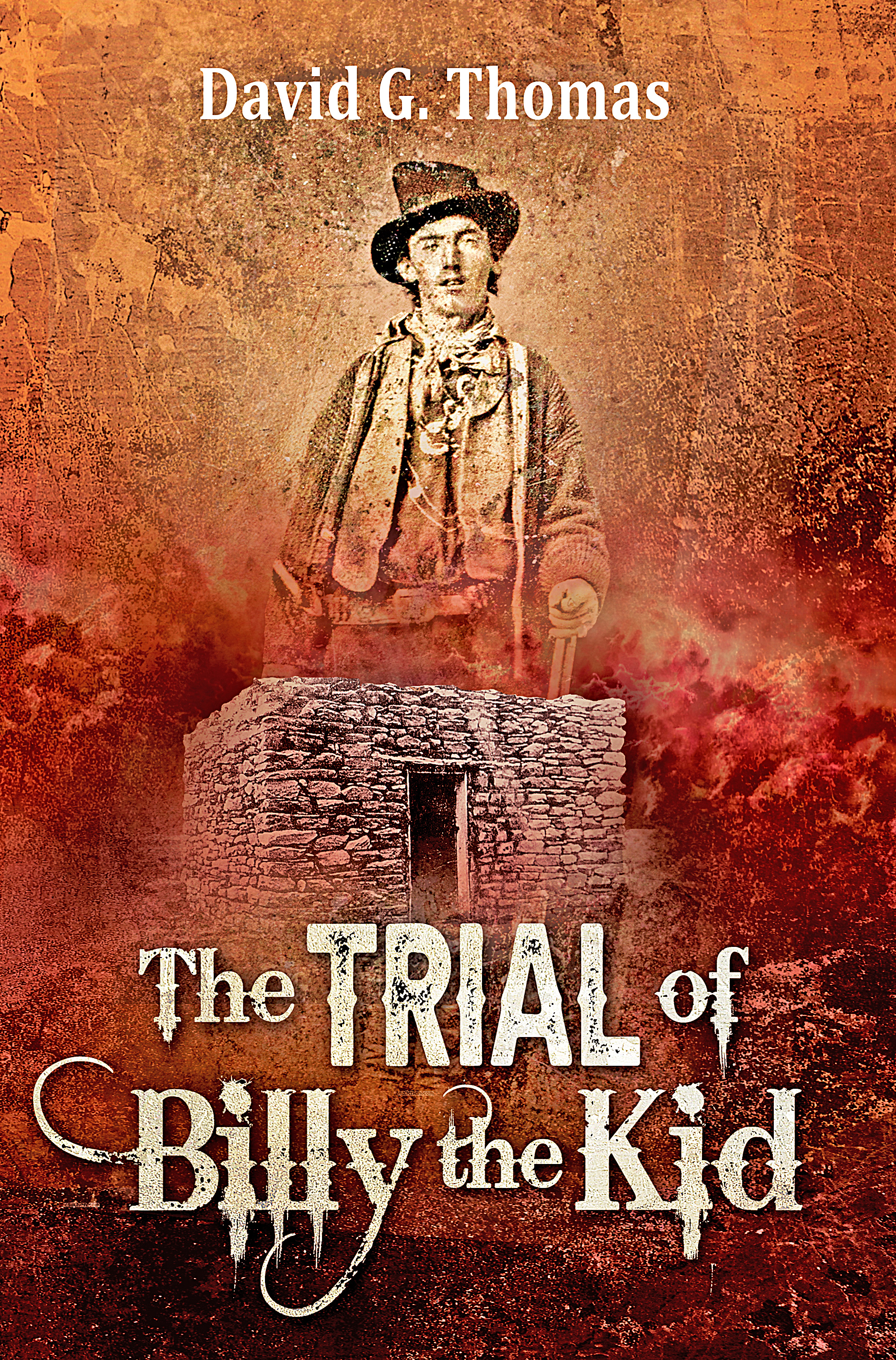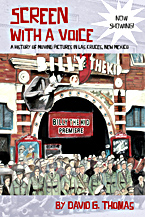Wednesday, June 13th, 2018
A life-sized statue of Giovanni Maria de Agostini has been erected in Capela do Alto, a town in the Brazilain state of São Paulo. Agostini is known in Brazil as João Maria D’Agostini or Monge Giovanni Maria D’Agostini (Monk). In New Mexico he is known as El Ermitaño (The Hermit).
Agostini lived in Brazil from December, 1842, to February, 1852.
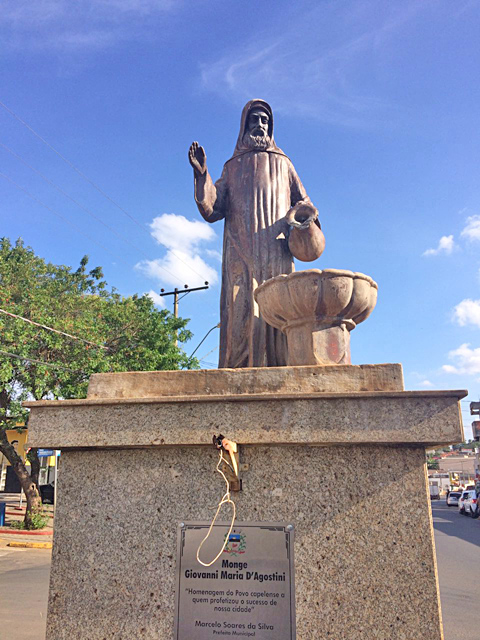
Statue of Giovanni Maria de Agostini, Capela do Alto, São Paulo, Brazil.
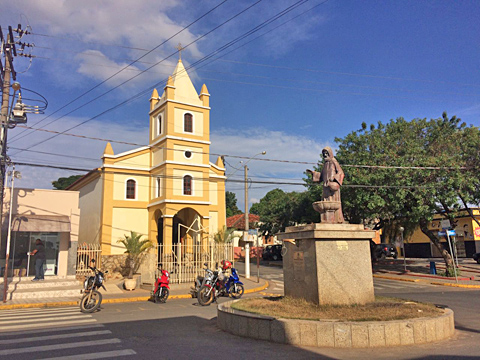
Statue of Giovanni Maria de Agostini, Capela do Alto, São Paulo, Brazil.

Plaque – Giovanni Maria de Agostini, Capela do Alto, São Paulo, Brazil.
Thursday, November 2nd, 2017
A Brazilian film production company, Realizart Produção Audiovisual LTDA, is making a documentary about Giovanni Maria de Agostini, the “Hermit of Las Cueva,” based on the book Giovanni Maria de Agostini, Wonder of the Century — The Astonishing World Traveler Who Was A Hermit.
Shooting began in New Mexico in September, 2017. From New Mexico, shooting will move to Brazil, Argentina, Peru, and Italy. Final shooting is expected to be completed in late September, 2018.
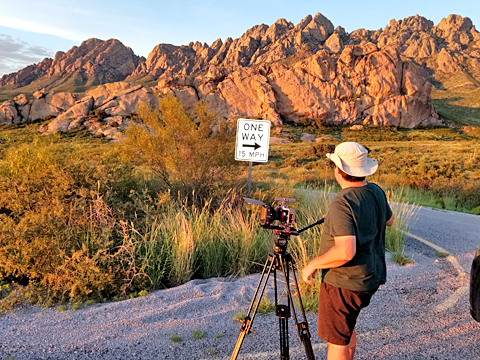
Ralf Tambke, Director of Photography (Realizart Produção Audiovisual LTDA), shooting for the documentary “The Hermit of La Cueva” at Dripping Springs Nature Area. The entrance to La Cueva is at the base of the distant rock formation.

Marcia Paraiso, Film Director, and Ralf Tambke, Director of Photography (Realizart Produção Audiovisual LTDA), shooting for the documentary “The Hermit of La Cueva” in La Cueva (the cave) at Dripping Springs Nature Area.

Shooting the documentary “The Hermit of La Cueva” at San Albino Basilica, Mesilla, New Mexico. Left to right: Juliana Baratieri, Sound Engineer, Marcia Paraiso, Film Director, Dr. Alexandre Karsburg, consultant, Ralf Tambke, Director of Photography (Realizart Produção Audiovisual LTDA).
Giovanni Maria de Agostini was born in Sizzano, Italy, in 1801, the son of poor farm workers. He left home at 21 and spent the next 17 years traveling extensively in Europe. During this time he developed two seemingly contradictory aspirations: a fervent desire to devote his life to “perfect solitude” and an astonishing urge to travel incessantly.
In 1839, Agostini joined a Maronite Christian monastery in Rome, and then immediately left for South America.
In South America Agostini visited Venezuela, Colombia, Ecuador, Bolivia, Peru, Brazil, Argentina, Paraguay, and Chile — multiple times. During this spectacular solo Odyssey, he survived a trip down the Amazon River by canoe, crossed the Andes by foot several times, walked vast distances, and endured living alone in scalding deserts and sub-zero mountains. In spite of oppressive and infuriating obstacles, including death threats, unjust arrest, deportation, jail, and forced confinement in a mental asylum, Agostini persisted undeterred in the solemn goal he set for himself when he left Europe.
After 21 years in South America, Agostini traveled to Mexico, Cuba, and the United States. After arriving in New York, he walked to Canada and then “went West,†eventually reaching, in the midst of the American Civil War, the Territory of New Mexico.
Hermit’s Peak near Las Vegas, NM is named after Agostini.
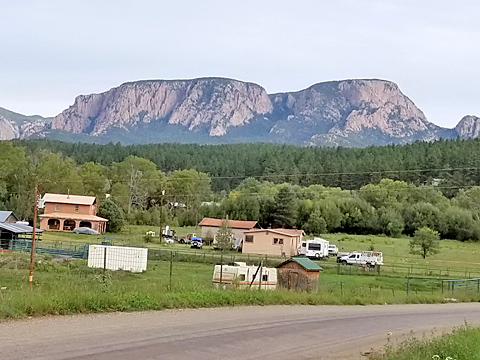
Hermit’s Peak, Las Vegas, New Mexico, named after Giovanni Maria de Agostini. Town of Gallinas, New Mexico, in foreground.
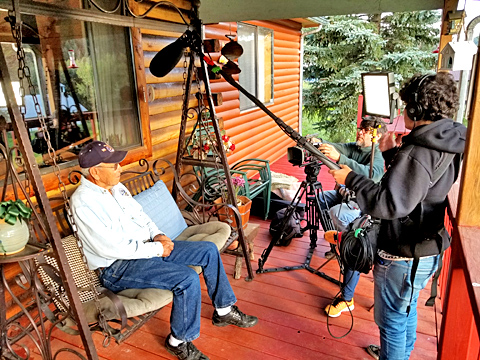
Interview with Mr. Joe Blea, a third-generation resident of Gallinas, New Mexico. Mr. Blea’s grandfather knew Giovanni Maria de Agostini.

“Hermit of Las Vegas” film crew preparing to climb Hermit’s Peak, Las Vegas, New Mexico.
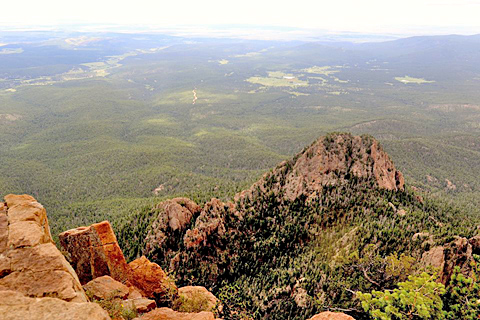
View from the top of Hermit’s Peak, Las Vegas, New Mexico.
In 1869, Agostini was murdered at “La Cueva,” the cave in the Organ Mountains’ Dripping Springs Natural Area. He is buried in the Mesilla cemetery.

Shooting the documentary “The Hermit of La Cueva” at Giovanni Maria de Agostini’s grave, Mesilla, New Mexico. Left to right: Marcia Paraiso, Film Director, Ralf Tambke, Director of Photography, Juliana Baratieri, Sound Engineer (Realizart Produção Audiovisual LTDA).
Monday, January 30th, 2017
Billy the Kid’s Grave – A History of the Wild West’s Most Famous Death Marker
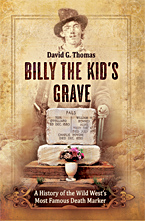
“Quien es?”
The answer to this incautious question – “Who is it?” – was a bullet to the heart.
That bullet – fired by Lincoln County Sheriff Patrick F. Garrett from a .40-44 caliber single action Colt pistol – ended the life of Billy the Kid, real name William Henry McCarty.
But death – ordinarily so final – only fueled the public’s fascination with Billy the Kid.
What events led to Billy’s killing? Was it inevitable? Was a woman involved? If so, who was she?
Why has Billy’s gravestone become the most famous – and most visited – Western death marker? Is Billy really buried in his grave? Is the grave in the right location?
Is it true that Pat Garrett’s first wife is buried in the same cemetery? Is Billy’s girlfriend buried there also?
The Fort Sumner cemetery where Billy’s grave is located was once plowed for cultivation. Why?
What town, seeking a profitable tourist attraction, tried to move Billy’s body, using a phony relative to justify the action?
These questions – and many others – are answered in this book.
The book is divided into three sections. The first gives an account of the chain of events that led directly to Billy’s death, beginning the singular event that started the sequence, Billy’s conviction for murder and his sentencing to hang. As much as possible, these events are related using the actual words of witnesses and contemporaries. The second chapter tells the story of Billy’s burial and the many surprising incidents associated with his grave over the years. The third chapter lists the 111 men and women known to be buried along with Billy in the Fort Sumner cemetery, with short biographies. Sixteen of these individuals had very direct connections with Billy. Appendix A supplies Charles W. Dudrow’s correspondence regarding the locating and disinterring of the military burials at Fort Sumner. Appendix B reprints the only newspaper interview ever granted by Sheriff Patrick F. Garrett on the killing of Billy the Kid.
To supplement this history are 65 photos and illustrations. These include photos of the different memorials that have marked Billy’s grave over the years, including a photo of Billy’s previously-unknown second grave marker; pictures of the men – friends of Billy – who re-located the grave in 1931; pictures of Billy’s most likely girlfriend, Paulita Maxwell, and her parents; and a historic 1906 Fort Sumner cemetery map showing the location of Billy’s grave.
Paperback, 154 pages. Available at Amazon.
See Also:
Did Billy the Kid stay at La Posta in Mesilla
Pat Garrett Marker
Shootout at the O. K. Corral — 133 Years Ago Today
New Book on Las Cruces History
Death of Johnny Ringo – King of the Cowboys
The Arizona Cowboy
Saturday, February 20th, 2016
“There is going to be a real old-fashioned lynching on the Rio Grande….”
With these words, the Las Cruces newspaper announced that Clint Eastwood would soon arrive in Las Cruces — to film HANG ‘EM HIGH.
The co-producer of the movie, Leonard Freeman, had been in town for several days and had already found the perfect location for the opening scene: a spectacular, lonely tree on the west bank of the Rio Grande River, about 12 miles north of Las Cruces.
In the opening scene, which appears even before the credits, Eastwood is dragged across the Rio Grande River, and then lynched.

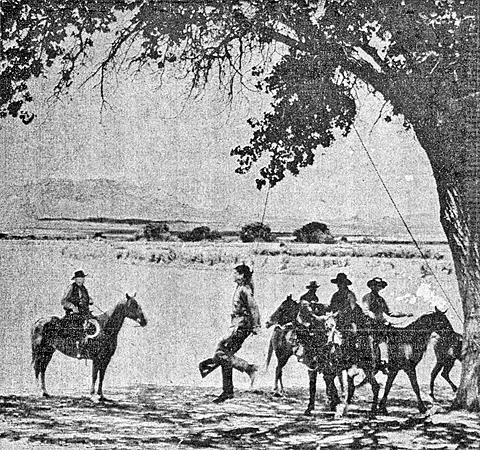
The lynching is the driving event of the movie. Eastwood plays ex-lawman Jed Cooper. He is herding cattle he has just purchased back to his ranch when he is brutally arrested by a citizen’s posse. Unknown to the posse, the person who sold the cattle to Cooper had killed the true owners just prior to selling them to Cooper. The remainder of the movie consists of Cooper ruthlessly pursuing the men responsible for his hanging and enacting suitable revenge.

Formal shooting of the film began June 21, 1967. The hanging scene was filmed June 29. Eastwood did the entire scene himself, except for the swinging by his neck, which was done by his stunt double Walter Scott (shown in photo). The Las Cruces location shooting wrapped July 1.
The tree where Eastwood was hung is no longer standing and the riverbed is now overgrown with thick brush.
Source: Screen With A Voice: A History of Moving Pictures in Las Cruces, New Mexico
See also:
Screen With A Voice – A History of Moving Pictures in Las Cruces, New Mexico
Rio Grande Theatre
Rio Grande Theatre – More History
Tuesday, November 24th, 2015
Screen With A Voice – A History of Moving Pictures in Las Cruces, New Mexico
 The first projected moving pictures were shown in Las Cruces 110 years ago. Who exhibited those movies? What movies were shown? Since projected moving pictures were invented in 1896, why did it take ten years for the first movie exhibition to reach Las Cruces? Who opened the first theater in town? Where was it located? These questions began the history of moving pictures in Las Cruces, and they are answered in this book. But so are the events and stories that follow.
The first projected moving pictures were shown in Las Cruces 110 years ago. Who exhibited those movies? What movies were shown? Since projected moving pictures were invented in 1896, why did it take ten years for the first movie exhibition to reach Las Cruces? Who opened the first theater in town? Where was it located? These questions began the history of moving pictures in Las Cruces, and they are answered in this book. But so are the events and stories that follow.
First movie shown in Las Cruces
First theater in Las Cruces
First talkie shown in Las Cruces
Invention of drive-in theater in Las Cruces
Opening of Rio Grande Theater
Impact of Great Depression on business
Raffle of six-week-old baby girl at Mission Theater
World premiere of first BILLY THE KID movie
Second world premiere of a BILLY THE KID movie
Arrival of Organ, Rocket, Fiesta, and Aggie Drive-Ins
Shooting of Clint Eastwood’s HANG ‘EM HIGH
There have been 21 movie theaters in Las Cruces – all but three or four are forgotten. They are unremembered no longer. And one, especially, the Airdome Theater which opened in 1914, deserves to be known by all movie historians – it was an automobile drive-in theater, the invention of the concept, two decades before movie history declares the drive-in was invented.
To supplement this history are 102 photos and illustrations. These include ephemeral documents such as the 4-page flyer for Las Cruces’ third movie exhibition, at the Rink Theater; historic photos of theaters; aerial photos of drive-ins; and never-before-published photos of the shooting of HANG ‘EM HIGH.
Winner 2017 Pasajero Del Camino Real Award for best history book on Southern New Mexico.
Cover: Depicts the 1930 world premiere of BILLY THE KID, starring John Mack Brown as Billy, at the Rio Grande Theater in Las Cruces.
See also:
HANG ‘EM HIGH
Rio Grande Theatre
Rio Grande Theatre – More History
Wednesday, November 11th, 2015
The word usage “cowboy” was not widespread in the press until it began to be used to describe the “cowboys” of Arizona. Although the word was always associated with cattle wrangling, during the late 1870s and early 1880s, cattle wranglers who were willing to cross the line to robbery and rustling began to formally self-describe themselves as “cowboys,” which was picked up by the Western press. In Arizona, they often wore red bandanas as an informal mark of membership. Johnny Ringo, before his suicide, was often referred to as the “King of the Cowboys.”
The Arizona Cowboy
“…The cowboy is a cross between a vaquero and a highwayman, which intensifies the worst qualities of each type. He is given to drink and to quarreling. He is hostile, on general principles, to everybody more civilized than himself. He detests ‘boiled shirts’ and ‘plug’ hats, and he will do the incautious wearers of those garments whatever injury he may. He is a thief as well as a murderer, and thinks nothing of stopping stages and stealing cattle.”
“As the cowboys are numerous, it is to be feared that they will oppose a prolonged and measurably successful resistance to the spasmodic raids upon them, and that they will render life on the frontier equally exciting and precarious for some time to come. The status they occupy in the general scheme of American civilization may be shown by an illustration When, in the West Indies, the sugar cane is being cut, it is the practice to leave a patch of cane in the middle of the field. The reason is that as the cutting proceeds all the venomous reptiles that inhabit the cane retire before the hands until they reach the center. Thus, there is a little patch which at last becomes full of them, and that patch is set on fire and burned. Now the cowboys are the venomous creatures which have been driven from both sides towards this patch of country by the advance of civilization, and when their habitat is reached it is naturally found to be very disagreeable. They will have to make way for settlement and honest industry, however, even if the last man among them dies in his boots.”
The Daily Record-Union, June 17, 1881
See Also:
Death of Johnny Ringo – King of the Cowboys
Shootout at the O. K. Corral — 133 Years Ago Today
Wednesday, October 21st, 2015
DEATH OF JOHN RINGO
His Body Found in Morse’s Canyon – Probable Suicide
“Sunday evening intelligence reached this city of the finding of the dead body of John Ringo near the mouth of Morse’s canyon in the Chiricahua mountains on Friday afternoon.”
“There was [sic] few men in Cochise county, or Southeastern Arizona better known. He was recognized by friends and foes as a recklessly brave man, who would go any distance, or undergo any hardship to serve a friend or punish an enemy. While undoubtedly reckless, he was far from being a desperado, and we know no murder being laid to his charge. Friends and foes are unanimous in the opinion that he was a strictly honorable man in all his dealings, and that his word was as good as his bond. Many people who were intimately acquainted with him in life have serious doubts that he took his own life, while an equally large number say that he frequently threatened to commit suicide, and that event was expected at any time.”
“The circumstance of the case hardly leave any room for doubt as to his self destruction. He was about 200 feet from water, and was acquainted with every inch of the country, so that it was almost impossible for him to lose himself. He was found in the midst of a clump of oaks, springing from the same stem, but diverging outward so as to leave an open space in the centre. On top of the main stem and between the spreading boughs was a large stone, and on this pedestal he was found sitting, with his body leaning backward and resting against a tree.”
“He was found by a man named John Yost, who was acquainted with him for years, both in the Territory and Texas. Yost is working for Sorgum Smith, and was employed hauling wood. He was driving a team in the midst of the clump of trees, apparently asleep. He passed on without further investigation, but on looking back, saw his dog smelling of the man’s face and snorting. This excited curiosity, and he stopped the team, alighted, and proceeded to investigate. He found the lifeless body of John Ringo, with a hole large enough to admit two fingers about half way between the right eye and ear, and a hole correspondingly large on top of his head, doubtless the outlet of the fatal bullet. The revolver was firmly clenched in his hand, which is almost conclusive evidence that death was instantaneous. His rifle rested against a tree and one of his cartridge belts was turned upside down. Yost immediately gave the alarm, and in about fifteen minutes eleven men were on the spot. The subjoined statement made by the eye witnesses to Coroner Matthews:”
TURKEY OR MORSE’S MILL CREEK
“Statement for the information of the Coroner and Sheriff of Cochise county, Arizona:”
“There was found by the undersigned, John Yost, the body of a man in a clump of oak trees, about twenty yards north from the road leading to Morse’s mill, and about a quarter of a mile west of the house of B. F. Smith. The undersigned viewed the body and found it in a sitting posture, facing west, the head inclined to the right. There was a bullet hole on the top of the head on the left side. There is, apparently, a part of the scalp gone, including a small portion of the forehead and part of the hair. This looks as if cut out by a knife. These are the only marks of violence on the body.”
“Several of the undersigned identify the body as that of John Ringo, well known in Tombstone. He was dressed in light hat, blue shirt, vest, pants and drawers. On his feet were a pair of hose and an undershirt torn up so as to protect his feet. He had evidently traveled but a short distance in this foot-gear. His revolver he grasped in his right hand, his rifle resting against the tree close to him. He had on two cartridge belts, the belt for [the] revolver, calibre 45, No. 222, contained five cartridges; 1 Winchester rifle octagon barrel, calibre 45, model 1876, No. 21,896, containing a cartridge in the breech and ten in the magazine; 1 cartridge belt, containing 9 rifle cartridges; 1 cartridge belt, containing 2 revolver cartridges; 1 silver watch old American Watch company, No. 9339, with silver chain attached; two dollars and sixty cents ($2.60) in money; 6 pistol cartridges in pocket; 5 shirt studs; 1 small pocket knife; 1 tobacco pipe; 1 comb; 1 block matches; 1 small piece tobacco. There is also a portion of a letter from Messrs. Hereford & Zabriskie, attorneys-at-law, Tucson, to the deceased, John Ringo. The above property is left in the possession of Frederick Ward, teamster between Morse’s mill and Tombstone.”
“The body of deceased was buried close to where it was found.”
“When found deceased had been dead about twenty-four hours.”
[signed]
“Thomas White, John Blake, John W. Bradfield, B. F. Smith, A. E. Lewis, A. S. Neighbors, James Morgan, Robert Bolter, Frank McKenney, W. J. Dowelt, J. C. McGray, John Yost, Fred Ward.”
“From Fred Ward, who arrived in the city on Sunday evening, an EPITAPH reporter learned that the general impression prevailing among people in the Chiricahuas is that his horse wandered off somewhere, and he started off on foot to search for him; that his boots began to hurt him, and he pulled them off and made moccasins of his undershirt. He could not have been suffering for water, as he was within 200 feet of it, and not more than 700 feet from Smith’s house.”
“Mrs. Morse and Mrs. Young passed by where he was lying Thursday afternoon, but supposed it was some man asleep, and took no further notice of him. The inmates of Smith’s house heard a shot about three o’clock Thursday evening, and it is more than likely that that is the time the rash deed was done. He was on an extended jamboree the last time he was in this city, and only left here ten days ago. He had dinner at Dial’s in the South Pass of the Dragoons one week ago last Sunday, and went from there to Galeyville, where he kept on drinking heavily.”
“We have not heard of his whereabouts after leaving Galeyville, but it is more than likely he went to Morse’s canyon. He was subject of frequent fits of melancholy and had an abnormal fear of being killed. Two weeks ago last Sunday in conversing with the writer, he said he was as certain of being killed, as he was of being living then. He said he might run along for a couple of years more, and may not last two days.”
“He was born in Texas and is very respectably connected. He removed to San Jose, California, when about sixteen years old, and Col. Coleman Younger, one of the leading citizens of that town is his grandfather. Ringo was a second cousin to the famous Younger brothers now in Minnesota penitentiary, for their partnership with the James boys. He has three sisters in San Jose, of whom he was passionately fond. He was about thirty-eight years old, though looking much younger, and was fine specimen of physical manhood. Many friends will mourn him, and many others will take secret delight in learning of his death.”
Tombstone Weekly Epitaph, July 22, 1882.
See Also:
The Arizona Cowboy
Shootout at the O. K. Corral — 133 Years Ago Today
Sunday, October 26th, 2014
The renowned shootout at the O. K. Corral, the subject of innumerable books and movies, the source of Wyatt Earp’s and his brothers’ enduring fame, occurred 133 years ago. An excellent, eye-witness account of the gunfight was printed in the San Francisco Chronicle several days latter, and republished in newspapers across the country, including in the local Las Cruces paper, the Rio Grande Republican. Here is that account:
A STREET FIGHT
Three Cowboys Killed in a Battle in Tombstone
“A Tombstone, Arizona, special to the San Francisco Chronicle of the 27th ult., gives the following graphic account of the fight between cowboys and the authorities of the town:”
“The liveliest street battle that ever occurred in Tombstone took place at 2:30 P. M. to day, resulting in the death of three persons and the wounding of two others, one probably fatally. For some time past several cowboys have been in town, and the fight was between City Marshal Virgil Earp, his two brothers, Morgan and Wyatt Earp, and Dock (sic) Holliday on one side, and Ike and Billy Clinton and Frank and Tom McLowery on the other. The Clanton and McLowery brothers are known as cowboys, and Ike has been in town for the past week drinking pretty freely, and was arrested this morning for carrying concealed weapons, he having appeared on the street with a Winchester rifle and six-shooter on. After paying his fine he is reported to have made threats against Marshal Earp and his brothers, and it is known that bad blood has existed between them for some time. About 2:30 o’clock the Marshal requested his brothers, Morgan and Wyatt, and Dock Holliday to accompany him to aid in disarming the cowboys, as trouble was feared in the evening. They started down toward the O. K. Corral on Fremont street, and a few doors below the Nugget office saw the two Clantons and the McLowery brothers talking to Sheriff Beban, who had requested them to disarm. The Marshal called out, ‘Boys, throw up your hands; I want you to give up your shooters.’”
THIRTY SHOTS IN A MINUTE
“At this Frank McLowery attempted to draw his pistol, when Wyatt Earp immediately shot him, the ball entering just about the waist. Dock Holliday then let go at Tom McLowery with a shotgun, filling him full of buckshot under the right arm. Billy Clanton then blazed away at Marshal Earp, and Ike Clanton, who it is claimed was unarmed, started and ran off through the corral to Allen street. The firing then became general, and some thirty shots were fired, all in such rapid succession that the fight was over in less than a minute. When the smoke cleared away it was found that Frank McLowery had been killed outright, with one ball through the intestines, one in the left breast, and one in the right temple, the latter two wounds being received at the same instant. Tom McLowery lay dead around the corner of Third street, a few feet from Fremont’s, the load of buckshot fired by Holliday killing him instantly. Billy Clanton lay on the side of the street, with one shot in the right waist and another in the right side, near the wrist, and the third in the left nipple. He was taken into a house and lived about half an hour in great agony.”
INJURIES OF THE WOUNDED
“Morgan Earp was shot through both shoulders, the ball creasing the skin. Marshal Earp was shot through the fleshy part of the right leg. Wyatt Earp and Dock Holiday escaped unhurt. The shooting created great excitement, and the street was immediately filled with people. Ike Clayton was captured and taken to jail, where he now remains. The jail is guarded by a number of citizens to prevent lynching, of which there is no apparent danger. The three dead bodies were removed to the Morgue, where they now lie. It is reported that several thousand dollars were found on the bodies. The feeling of the better class of citizens is that the Marshal and his posse acted solely in the right in attempting to disarm the cowboys, and it was a case of kill or get killed. Clayton’s father was killed with four others a few months ago in New Mexico by the Mexicans while driving a band of cattle up to this market. The town is fairly quiet, and the authorities are fully able to maintain order.”
Rio Grande Republican, November 5, 1881.
See Also:
The Arizona Cowboy
Death of Johnny Ringo – King of the Cowboys
Thursday, July 10th, 2014
Giovanni Maria de Agostini, Wonder Of The Century — The Astonishing World Traveler Who Was A Hermit
 This book is about a remarkable man, Giovanni Maria de Agostini, born in Italy in 1801, who combined two seemingly contradictory aspirations: a fervent desire to devote his whole life to “perfect solitude†and an astonishing urge to travel incessantly.
This book is about a remarkable man, Giovanni Maria de Agostini, born in Italy in 1801, who combined two seemingly contradictory aspirations: a fervent desire to devote his whole life to “perfect solitude†and an astonishing urge to travel incessantly.
As his decisions and actions emerge from the lightless silence – the time-covered past – a unifying purpose becomes evident.
Following extensive travel in Europe, Agostini takes vows revocable only by formal dispensation from the Pope. He immediately leaves forever his “beloved Italy†for South America. Twenty-one years he spends traversing that, at the time, greatly unexplored continent, visiting Venezuela, Colombia, Ecuador, Bolivia, Peru, Brazil, Argentina, Paraguay, and Chile – and so doing multiple times. During this spectacular solo Odyssey, he survives a trip down the Amazon River by canoe, crosses the Alps by foot several times, walks vast distances, and endures living alone in scalding deserts and subzero mountains. In spite of oppressive and infuriating obstacles, including death threats, unjust arrest, deportation, jail, and forced confinement in a mental asylum, Agostini persists undeterred in the solemn goal he set for himself when he left Europe.
Seeking change and another continent, Agostini leaves South America for Mexico, passing through Panama and Guatemala, and then Mexico for North America, passing through Cuba. In Cuba, he is hailed as an extraordinary adventurer, his photograph is taken, and he is proclaimed “The Wonder of Our Century.†After arrival in New York, he walks to Canada, where he spends almost a year, then “goes west,†eventually reaching, in the midst of the American Civil War, the Territory of New Mexico, where he meets his merciless fate.
Agostini is remembered in many places — in South America as Monge João Maria, in North America as Ermitaño Don Juan Agostini; however his life story is encrusted with myth and false fact. As the veritable events of his life are unveiled, a man of fascinating originality, prodigious endurance, intelligence, self-discipline, and self-sufficiency, infused with an indomitable spirit of adventure, emerges.
Today in Argentina, as many as 15,000 people participate in a yearly festival initiated by Agostini at Cerro Monje, “Monk’s Hill.†In Brazil, at Cerro Campestre, “Campestre Hill,†and Santo Cerro do BotucaraÃ, “Holy Hill of BotucaraÃ,†over 10,000 people celebrate annual events founded by Agostini. In Lapa, Brazil, a national park protects the pilgrimage route to Gruta do Monge, “Monk’s Grotto.†At Araçoiaba Hill, near Sorocaba, Brazil, the Trilha da Pedra Santa, “Trail of the Holy Rock,†is climbed annually by thousands of people desiring to pay respect to the memory of the Monge do Ipanema, the “Monk of Ipanema.â€
These are just a few examples of Agostini’s cultural legacy, 145 years after his death.
“David G. Thomas has finally pulled back the veil of obscurity that long shrouded one of the most enduring mysteries in New Mexico’s long history to reveal the true story of the Hermit, Giovanni Maria de Agostini. Tracking Agostini from Italy throughout South and North America to his final resting place in Mesilla, Thomas has once again proven himself a master history detective. Of particular interest is the information about the Hermit’s life in Brazil, which closely parallels his remarkable experience in New Mexico, and required extensive research in Portuguese sources. Thomas’s efforts make it possible to understand this deeply religious man.†— Rick Hendricks, New Mexico State Historian
20 maps and 65 photos, including 2 rare photos of Agostini, one taken in 1857 and one taken in 1861.
Table of Contents here.
E-Book here
See also:
La Cueva – Hermit’s Cave
Thursday, September 19th, 2013
“Best history of Mesilla.”
“La Posta: From the Founding of Mesilla, to the Corn Exchange Hotel, to Billy the Kid Museum, to Famous Landmark” consists of 5 sections:
- Chapter 1 is a history of Mesilla, beginning with its founding in 1850 by Rafael Ruelas.
- Chapter 2 gives the original and early ownership of all the properties around the public square in Mesilla, identifying previously uncertain locations such as the Butterfield Overland Stage location.
- Chapter 3 is a history of the Corn Exchange Hotel, founded in 1874, the most famous hotel in New Mexico at the time. Almost all the major participants of the Lincoln County War stayed at the hotel.
- Chapter 4 is a history of the Billy the Kid museum and its founder, Mesilla pioneer and impresario George Griggs.
- Chapter 5 is a history of La Posta, Mesilla’s most famous landmark.
“Mesilla is full of Billy the Kid history. It’s where he started off rustling with Jesse Evans and it’s where he was tried and convicted of murder. At one point, rumor has it, he even stayed at the Corn Exchange Hotel (along with many of the other heavy hitters from the Lincoln County War).”
“For someone who grew up in the area of Mesilla, it’s nice to have a well-researched book about the area — and the giant photographs don’t hurt either (honestly, I love to see photos that take up the whole page so you can actually make out the detail)….”
“And the thing I was most excited to see is a photo of the hotel registry where the name of “William Bonney” is scrawled on the page. I knew this registry had existed at one point but I always thought it was missing…. There is some debate as to whether or not Billy the Kid really signed the book, which the author goes into, but what would Billy the Kid history be without a little controversy.”
— Billy the Kid Outlaw Gang Newsletter, Winter, 2013
See also:
Billy the Kid’s Grave – New Book
Pat Garrett’s Marker

















